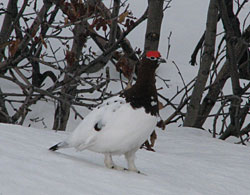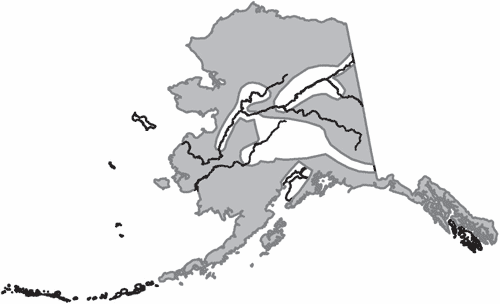Small Game Hunting in Alaska
Small Game Species — Willow Ptarmigan
Willow Ptarmigan
(Lagopus lagopus)
Habitat
Like the other ptarmigan species, the willow ptarmigan nests in sparsely timbered or treeless areas. It favors willow-lined waterways, either on the coastal plains of western and northern Alaska or in subalpine areas throughout the rest of the state. Tall bushes are an important feature for willow ptarmigan. These birds choose wetter places and more luxuriant vegetation for breeding than the other two species of ptarmigan. In winter, willow ptarmigan remain close to shrubby slopes and valleys, but they seek out areas at lower altitudes than what they use during the breeding season.
Identification
 The thick, wide bill is a trademark of all willow ptarmigan, the largest of our three ptarmigan species. Another distinction
is the white patch behind the male’s bill, lasting only two or three weeks in spring, before the chestnut plumage of early
summer comes in. Only another ptarmigan can distinguish cocks from hens when willow ptarmigan are in winter plumage. Then,
both sexes are white with black tail feathers. Beginning early in May the cocks develop a beautiful cape of chestnut-red
feathers. They court the hens in this plumage, not completing the change to the brown summer plumage until the hens are
nearly finished incubating the clutch of eggs.
The thick, wide bill is a trademark of all willow ptarmigan, the largest of our three ptarmigan species. Another distinction
is the white patch behind the male’s bill, lasting only two or three weeks in spring, before the chestnut plumage of early
summer comes in. Only another ptarmigan can distinguish cocks from hens when willow ptarmigan are in winter plumage. Then,
both sexes are white with black tail feathers. Beginning early in May the cocks develop a beautiful cape of chestnut-red
feathers. They court the hens in this plumage, not completing the change to the brown summer plumage until the hens are
nearly finished incubating the clutch of eggs.
No sooner does the male get this first set of dark chestnut feathers, however, than a new generation of lighter brown feathers grows on its neck and breast. This new set is never completed, because by early August the cock is beginning to grow white feathers for the coming winter plumage. In mid-August male ptarmigan are a patchwork of four sets of feathers; a few old winter feathers on the wings, new white feathers on toes and belly, and parts of the light spring and darker summer feathers.
Behavior
Driven by their reproductive urge, cocks become less and less tolerant of each other throughout March and April. In early spring, males stake claims to parcels of ground that they defend in good weather, but spring snowstorms will send these males back into flocks. By late April or early May, males establish permanent territories that they defend in fair weather or foul. Hens arrive on the breeding grounds a bit later than males and then select their mates and nesting areas (often the same ones used the previous year). By late May the first eggs are laid under a shrub at the edge of an opening. The cocks stay on their territories throughout June, although the intense strutting, tailfanning and aerial chasing typical of the courtship period wanes after the hens begin to incubate their clutch, which averages between six to ten eggs. Most Alaskan ptarmigan chicks hatch in late June and early July.
Unlike other North American grouse or ptarmigan, male willow ptarmigan usually help to care for their chicks. Sometimes, in fact, cocks will take over all family responsibilities if the hen is killed. Both adult willow ptarmigan are vigorous in their defense of the brood. One of the thrills in store for the Alaskan traveler is the chance to watch the excited actions of a female ptarmigan as she tries to distract attention from her chicks by simulating injury or to duck the flailing wings of the cock as he dives at the two-legged intruder, cackling gutterally as he flies.
Despite all of this care, young ptarmigan encounter many things that can kill them unless they are vigorous and lucky. Poor weather too soon after hatching, the quick pounce of the fox or the swift swoop of the hawk, chance separation from the family, and diseases like coccidiosis, all can be fatal. In most years, 65 to 80 percent of all chicks die before they are 11 months old. A ptarmigan’s life expectancy brightens a little once it reaches maturity since adults die at the rate of about 50 to 60 percent per year. At that rate, a 4-yearold ptarmigan is a fortunate bird. The abundance of ptarmigan at any time is the result of the reproductive success minus the deaths during the previous two years. Ptarmigan numbers can build up with astonishing speed given favorable conditions, but often decline just as rapidly.

Families of willow ptarmigan join to form flocks in September. The ptarmigan then begin to move around more than in the nesting season. Females and males tend to separate in late September and October; the females, usually in small groups, seek food and shelter at lower elevations. In most parts of Alaska these movements to and from summer ranges encompass only a few miles. In other parts of the state good wintering places are far from the breeding grounds. For example, hens that nest or were reared on the north slope of the Brooks Range move up to 100 miles southward in late fall, wintering on the south side of the Brooks Range in the low hills and wooded valleys north of the Yukon River in the east, or in the valleys of the Noatak and Kobuk Rivers to the west. Males of these same populations also largely abandon summer ranges, but do not go as far south as the females. The south-tending migrations take place in October and November. The northward movements begin in February, reach a peak in April, and are finished by mid-May.
The willow ptarmigan has an appropriate name. Not only are willows important nesting habitat, they are also the bird’s most important food source. The leaves of willow shrubs often outrank any other item eaten in summer. In winter the buds, twigs, and catkins of willows provide four-fifths or more of their food. Because moose and snowshoe hare also rely on willows for sustenance, it is fortunate that these shrubs are so widespread in Alaska, and are able to rapidly recover from severe browsing.
As with the other ptarmigan species, willow ptarmigan feed on berries in the fall and also eat overwintered berries in the spring.
Where to Find Them
In Southeast Alaska, several trails lead to ptarmigan country from roads close to Juneau. Willow ptarmigan are common along a 20-mile section of the Haines Highway through Chilkat Pass beginning 65 miles north of Haines.
A few miles north of Valdez, the Richardson Highway snakes its way to the crest of Thompson Pass in the Chugach Mountains and winds through good ptarmigan country for nearly 10 miles.
In the Alaska Range these birds can be found in willow thickets and shrub areas above treeline across the Denali Highway, along the Richardson Highway from Paxson to Black Rapids, and along the Parks Highway for several miles either side of Cantwell. Visitors to Denali National Park are likely to see families of willow ptarmigan at streams along the length of the park road. Further north, willow ptarmigan are occasionally seen at various places along higher parts of the Steese and Taylor Highways, both of which span mountains between the Tanana and Yukon Rivers.
On the Seward Peninsula, willow ptarmigan can be seen anywhere along the isolated road system fanning out from Nome.
Willow ptarmigan also live in many areas far from the highway system in Alaska. Some “hot spots” to find willow ptarmigan are the mountains at the east end of the Skilak and Tustumena Lakes on the Kenai Peninsula, the northwest side of the Alaska Peninsula, the Kotzebue Sound region, and various places in the Brooks Range, notably Anaktuvuk Pass.
Range of the Willow Ptarmigan in Alaska
Willow ptarmigan have the widest range in Alaska of any upland game bird, although rock ptarmigan are a close second. The only big areas without willow ptarmigan are in the broad, forested valleys of the Interior (even there you can sometimes find willow ptarmigan in winter), the thick woods of Southeast Alaska, and the Aleutian Islands west of Unimak Island. Willow ptarmigan also live in Canada, Scotland, Scandinavia, and Russia.

Videos
Willow Ptarmigan Capture and Radio Collaring
Willow Ptarmigan aerial display
